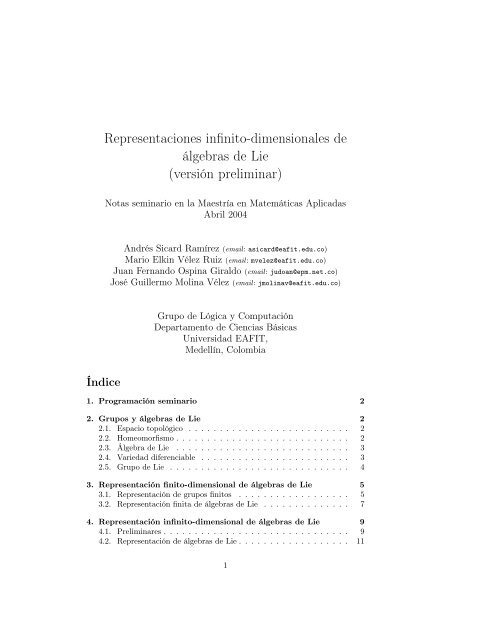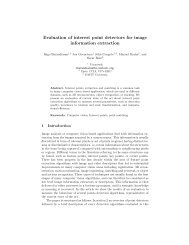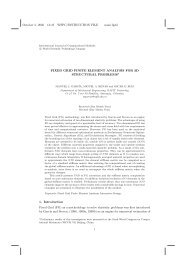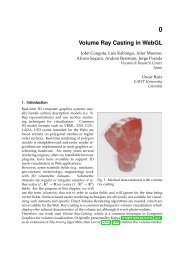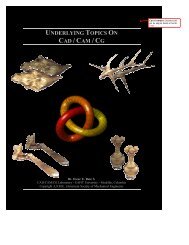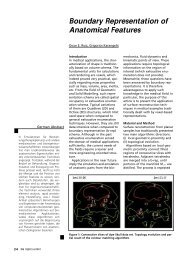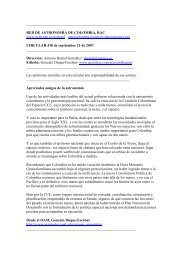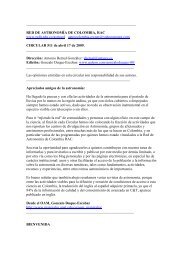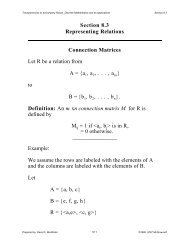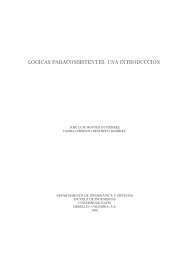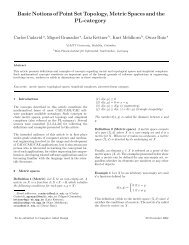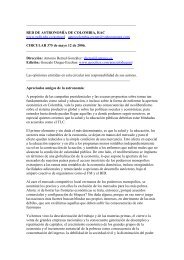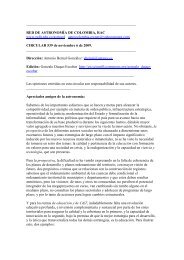Representaciones infinito-dimensionales de álgebras de Lie ...
Representaciones infinito-dimensionales de álgebras de Lie ...
Representaciones infinito-dimensionales de álgebras de Lie ...
Create successful ePaper yourself
Turn your PDF publications into a flip-book with our unique Google optimized e-Paper software.
<strong>Representaciones</strong> <strong>infinito</strong>-<strong>dimensionales</strong> <strong>de</strong><br />
álgebras <strong>de</strong> <strong>Lie</strong><br />
(versión preliminar)<br />
Notas seminario en la Maestría en Matemáticas Aplicadas<br />
Abril 2004<br />
Andrés Sicard Ramírez (email: asicard@eafit.edu.co)<br />
Mario Elkin Vélez Ruiz (email: mvelez@eafit.edu.co)<br />
Juan Fernando Ospina Giraldo (email: judoan@epm.net.co)<br />
José Guillermo Molina Vélez (email: jmolinav@eafit.edu.co)<br />
Grupo <strong>de</strong> Lógica y Computación<br />
Departamento <strong>de</strong> Ciencias Básicas<br />
Universidad EAFIT,<br />
Me<strong>de</strong>llín, Colombia<br />
Índice<br />
1. Programación seminario 2<br />
2. Grupos y álgebras <strong>de</strong> <strong>Lie</strong> 2<br />
2.1. Espacio topológico . . . . . . . . . . . . . . . . . . . . . . . . . . 2<br />
2.2. Homeomorfismo . . . . . . . . . . . . . . . . . . . . . . . . . . . . 2<br />
2.3. Álgebra <strong>de</strong> <strong>Lie</strong> . . . . . . . . . . . . . . . . . . . . . . . . . . . . 3<br />
2.4. Variedad diferenciable . . . . . . . . . . . . . . . . . . . . . . . . 3<br />
2.5. Grupo <strong>de</strong> <strong>Lie</strong> . . . . . . . . . . . . . . . . . . . . . . . . . . . . . 4<br />
3. Representación finito-dimensional <strong>de</strong> álgebras <strong>de</strong> <strong>Lie</strong> 5<br />
3.1. Representación <strong>de</strong> grupos finitos . . . . . . . . . . . . . . . . . . 5<br />
3.2. Representación finita <strong>de</strong> álgebras <strong>de</strong> <strong>Lie</strong> . . . . . . . . . . . . . . 7<br />
4. Representación <strong>infinito</strong>-dimensional <strong>de</strong> álgebras <strong>de</strong> <strong>Lie</strong> 9<br />
4.1. Preliminares . . . . . . . . . . . . . . . . . . . . . . . . . . . . . . 9<br />
4.2. Representación <strong>de</strong> álgebras <strong>de</strong> <strong>Lie</strong> . . . . . . . . . . . . . . . . . . 11<br />
1
4.3. Representación adjunta <strong>de</strong> su(1, 1) . . . . . . . . . . . . . . . . . 11<br />
4.4. Descomposición Cartan <strong>de</strong> su(1, 1) . . . . . . . . . . . . . . . . . 12<br />
4.5. Representación infinita <strong>de</strong> su(1, 1) . . . . . . . . . . . . . . . . . 14<br />
5. Análisis funcional con una representación <strong>infinito</strong>-dimensional<br />
<strong>de</strong> su(1, 1) 16<br />
5.1. Matemáticas para un mo<strong>de</strong>lo <strong>de</strong> hiper-computación cuántica . . 16<br />
5.2. Representación <strong>infinito</strong> dimensional <strong>de</strong> su(1, 1) . . . . . . . . . . 16<br />
5.3. Derivadas Fréchet en su(1, 1) . . . . . . . . . . . . . . . . . . . . 20<br />
5.4. Transformada Cayley . . . . . . . . . . . . . . . . . . . . . . . . . 20<br />
1. Programación seminario<br />
Miércoles 10 <strong>de</strong> marzo<br />
Introducción [11, 1]. Álgebras y grupos <strong>de</strong> <strong>Lie</strong> [8, 9, 13].<br />
Miércoles 17 <strong>de</strong> marzo<br />
<strong>Representaciones</strong> finito <strong>dimensionales</strong> <strong>de</strong> álgebras <strong>de</strong> <strong>Lie</strong> [2, 4, 15, 14]<br />
Miércoles 24 <strong>de</strong> marzo<br />
<strong>Representaciones</strong> <strong>infinito</strong> <strong>dimensionales</strong> <strong>de</strong> álgebras <strong>de</strong> <strong>Lie</strong> [2, 4, 7].<br />
Miércoles 31 <strong>de</strong> marzo<br />
Problema <strong>de</strong> investigación: Hipercomputación <strong>de</strong>s<strong>de</strong> la computación cuántica<br />
[12, 5].<br />
2. Grupos y álgebras <strong>de</strong> <strong>Lie</strong><br />
2.1. Espacio topológico<br />
Definición 2.1 (Espacio topológico). Sea X cualquier conjunto y τ = {U i |i ∈<br />
I} una colección <strong>de</strong> subconjuntos <strong>de</strong> X. el par (X, τ) es un espacio topológico si<br />
[8]<br />
X, ∅ ∈ τ<br />
Si J es cualquier subcolección finita o infinita <strong>de</strong> I, la familia {U j |j ∈ J}<br />
satisface ⋃ j∈J U j ∈ τ<br />
Si K es cualquier subcolección finita <strong>de</strong> I, la familia {U k |k ∈ K} satisface<br />
⋂<br />
k∈K U k ∈ τ<br />
2.2. Homeomorfismo<br />
Definición 2.2 (Homeomorfismo). Sean X 1 y X 2 dos espacios topológicos. Un<br />
mapa f: X 1 → X 2 es un homeomorfismo si f y f −1 son continuas [8].<br />
2
2.3. Álgebra <strong>de</strong> <strong>Lie</strong><br />
Definición 2.3 (Álgebra <strong>de</strong> <strong>Lie</strong>). Una álgebra <strong>de</strong> <strong>Lie</strong> g es un espacio vectorial<br />
junto con una operación [ , ]: g × g → g, <strong>de</strong>nominada el bracket o conmutador,<br />
tal que [13]<br />
La operación bracket es bilineal.<br />
[x, y] = −[y, x] para toda x ∈ g (anticonmutatividad).<br />
[[x, y], z] + [[y, z], x] + [[z, x], y] = 0 (i<strong>de</strong>ntidad <strong>de</strong> Jacobi).<br />
Ejemplo 2.1 (Espacio vectorial). R 3 con la operación bilineal X × Y producto<br />
vectorial, es una álgebra <strong>de</strong> <strong>Lie</strong>.<br />
Ejemplo 2.2 (Espacio vectorial). Cualquier espacio vectorial don<strong>de</strong> la operación<br />
bracket es igual a cero es una álgebra <strong>de</strong> <strong>Lie</strong>. Tal álgebra <strong>de</strong> <strong>Lie</strong> es llamada<br />
abeliana.<br />
Ejemplo 2.3 (El álgebra <strong>de</strong> <strong>Lie</strong> gl(n, R)). El conjunto <strong>de</strong> matrices gl(n, R)<br />
es un espacio vectorial <strong>de</strong> dimensión n 2 . Al dotar ese espacio con la operación<br />
[A, B] = AB − BA se obtiene una álgebra <strong>de</strong> <strong>Lie</strong>.<br />
Ejemplo 2.4 (El álgebra <strong>de</strong> <strong>Lie</strong> gl(n, C) ). El conjunto <strong>de</strong> matrices gl(n, C)<br />
es un espacio vectorial <strong>de</strong> dimensión 2n 2 . Al dotar ese espacio con la operación<br />
[A, B] = AB − BA se obtiene una álgebra <strong>de</strong> <strong>Lie</strong>.<br />
Ejemplo 2.5 (Matrices <strong>de</strong> traza cero). El conjunto <strong>de</strong> matrices sl(n, C) = {M ∈<br />
gl(n, C)|T rM = 0}, don<strong>de</strong> T rM es la traza <strong>de</strong> la matriz M, es una álgebra <strong>de</strong><br />
<strong>Lie</strong>.<br />
Ejemplo 2.6 (Matrices antihermíticas). El conjunto <strong>de</strong> matrices u(n, C) =<br />
{M ∈ gl(n, C)|M † = −M}, es una álgebra <strong>de</strong> <strong>Lie</strong>.<br />
Ejemplo 2.7 (Matrices antisimétricas). El conjunto <strong>de</strong> matrices o(n, C) =<br />
{M ∈ gl(n, C)|M t = −M}, es una álgebra <strong>de</strong> <strong>Lie</strong>.<br />
Las álgebras <strong>de</strong> <strong>Lie</strong> están íntimamente relacionadas con los grupos <strong>de</strong> <strong>Lie</strong>,<br />
las propieda<strong>de</strong>s <strong>de</strong> los grupos <strong>de</strong> <strong>Lie</strong> son reflejadas en sus álgebras <strong>de</strong> <strong>Lie</strong>.<br />
2.4. Variedad diferenciable<br />
Definición 2.4 (Variedad diferenciable). Una m-variedad diferenciable M se<br />
<strong>de</strong>fine como [8]:<br />
M es un espacio topológico<br />
M está dotado <strong>de</strong> una familia <strong>de</strong> pares {(U i , ϕ)}<br />
{U i } es una familia <strong>de</strong> abiertos la cual cubre a M<br />
ϕ i es un homeomorfismo <strong>de</strong> U i en un abierto U ′ i<br />
<strong>de</strong> Rm<br />
3
Figura 1: Compatibilidad<br />
Dados U i y U j tal que U i ∩U j ≠ ∅, el mapa ψ ij = ϕ i ϕ −1<br />
j <strong>de</strong> ϕ j (U i ∩U j ≠ ∅)<br />
a ϕ i (U i ∩ U j ≠ ∅) es infinitamente diferenciable. (Fig 1)<br />
Los grupos <strong>de</strong> <strong>Lie</strong> son varieda<strong>de</strong>s diferenciables en las cuales la operación <strong>de</strong><br />
grupo es suave.<br />
2.5. Grupo <strong>de</strong> <strong>Lie</strong><br />
Definición 2.5 (Grupo <strong>de</strong> <strong>Lie</strong>). Un grupo <strong>de</strong> <strong>Lie</strong> G es una variedad diferenciable<br />
la cual está dotada con una estructura <strong>de</strong> grupo tal que el mapa G × G → G<br />
<strong>de</strong>finido por (σ, τ) ↦→ στ −1 es C ∞ [13].<br />
Definición 2.6 (La acción <strong>de</strong> G sobre M). Sea G un grupo <strong>de</strong> <strong>Lie</strong> y M una<br />
variedad. La acción <strong>de</strong> G sobre M es un mapa diferenciable µ: G × M → M tal<br />
que<br />
1. µ(e, p) = p para todo p ∈ M<br />
2. µ(g 1 , µ(g 2 , p)) = µ(g 1 g 2 , p).<br />
Ejemplo 2.8 (Espacio euclidiano). El espacio euclidiano R con la adición vectorial<br />
es un grupo <strong>de</strong> <strong>Lie</strong>.<br />
Ejemplo 2.9 (Números complejos). El conjunto <strong>de</strong> los números complejos no<br />
nulos C ∗ dotados con la multiplicación es un grupo <strong>de</strong> <strong>Lie</strong>.<br />
De particular interés para las aplicaciones físicas son los grupos <strong>de</strong> matrices,<br />
los cuales son subgrupos <strong>de</strong> los grupos generales lineales <strong>de</strong> matrices GL(n, R)<br />
y GL(n, C).<br />
Ejemplo 2.10 (Grupo ortogonal). El conjunto <strong>de</strong> matrices O(n) = {M ∈<br />
GL(n, R)|MM t = M t M = I n }, don<strong>de</strong> (M t ) i,j = M j,i y la matriz I n es la<br />
i<strong>de</strong>ntidad n × n, es un grupo <strong>de</strong> <strong>Lie</strong>.<br />
4
Ejemplo 2.11 (El grupo especial lineal). El conjunto <strong>de</strong> matrices SL(n, R) =<br />
{M ∈ GL(n, R)|<strong>de</strong>tM = 1}, don<strong>de</strong> <strong>de</strong>tM es el <strong>de</strong>terminante <strong>de</strong> la matriz M, es<br />
un grupo <strong>de</strong> <strong>Lie</strong>.<br />
Ejemplo 2.12 (Grupo especial ortogonal). El conjunto <strong>de</strong> matrices SO(n) =<br />
{M ∈ GL(n, R)|MM t = M t M = I n , <strong>de</strong>tM = 1}, don<strong>de</strong> (M t ) i,j = M j,i y la<br />
matriz I n es la i<strong>de</strong>ntidad n × n, es un grupo <strong>de</strong> <strong>Lie</strong>.<br />
De manera análoga como se <strong>de</strong>finieron las matrices anteriores <strong>de</strong> entradas<br />
reales, se <strong>de</strong>finen los grupos generales lineales <strong>de</strong> matrices GL(n, C).<br />
Ejemplo 2.13 (Grupo unitario). El conjunto <strong>de</strong> matrices U(n) = {M ∈<br />
C|MM † = M † M = I n }, don<strong>de</strong> (M † ) i,j = ¯M j,i y la matriz I n es la i<strong>de</strong>ntidad<br />
n × n, es un grupo <strong>de</strong> <strong>Lie</strong>.<br />
Ejemplo 2.14 (El grupo especial lineal). El conjunto <strong>de</strong> matrices SL(n, C) =<br />
{M ∈ GL(n, C)|<strong>de</strong>tM = 1}, don<strong>de</strong> <strong>de</strong>tM es el <strong>de</strong>terminante <strong>de</strong> la matriz M, es<br />
un grupo <strong>de</strong> <strong>Lie</strong>.<br />
Ejemplo 2.15 (Grupo especial ortogonal). El conjunto <strong>de</strong> matrices SU(n) =<br />
{M ∈ GL(n, C)|MM † = M † M = I n , <strong>de</strong>tM = 1}, don<strong>de</strong> (M † ) i,j = ¯M j,i y la<br />
matriz I n es la i<strong>de</strong>ntidad n × n, es un grupo <strong>de</strong> <strong>Lie</strong>.<br />
3. Representación finito-dimensional <strong>de</strong> álgebras<br />
<strong>de</strong> <strong>Lie</strong><br />
3.1. Representación <strong>de</strong> grupos finitos<br />
Notación. Sea V un espacio vectorial sobre un campo F, tal que dim V = n.<br />
Sea G un grupo finito y sea GL(V ) = GL(n, F) el conjunto <strong>de</strong> transformaciones<br />
lineales invertibles en V , es <strong>de</strong>cir, el conjunto <strong>de</strong> automorfismos <strong>de</strong> V .<br />
Definición 3.1 (Representación <strong>de</strong> un grupo). Una representación <strong>de</strong> G en V<br />
es un homomorfismo [2, p. 3]<br />
σ: G → GL(V ),<br />
es <strong>de</strong>cir, σ(e) = I, σ(gh) = σ(g)σ(h), σ(g −1 ) = (σ(g)) −1 .<br />
La dimensión <strong>de</strong> la representación σ es dim V .<br />
Ejemplo 3.1 (Representación trivial).<br />
σ: G → GL(V )<br />
g ↦→ I<br />
Ejemplo 3.2. Para el grupo simétrico S 3 = {e, (12), (13), (23), (123), (132)},<br />
una representación sobre R 2 está dada por σ: S 3 → GL(R 2 ), don<strong>de</strong> [15]<br />
5
σ(e) =<br />
σ((23)) =<br />
( ) 1 0<br />
, σ((12)) =<br />
0 1<br />
( ) 1 −1<br />
, σ((123)) =<br />
0 −1<br />
( ) 0 1<br />
, σ((13)) =<br />
1 0<br />
( ) −1 1<br />
, σ((132)) =<br />
−1 0<br />
( ) −1 0<br />
,<br />
−1 1<br />
( ) 0 −1<br />
.<br />
1 −1<br />
Definición 3.2. Una acción <strong>de</strong> G en V es un mapa σ: G × V → V tal que [14]<br />
σ(e, v) = v,<br />
σ(g, σ(h, v)) = σ(gh, v).<br />
Definición 3.3. Una representación <strong>de</strong> G en V es una acción <strong>de</strong>l grupo G en<br />
V por mapas lineal invertibles.<br />
Ejemplo 3.3. <strong>Representaciones</strong> <strong>de</strong> S 3 en C:<br />
trivial: σ(g, z) = z<br />
altenartiva [15]: σ(g, z) = sgn(g)z, don<strong>de</strong> sgn(g) es el signo <strong>de</strong> la permutación<br />
Ejemplo 3.4. Representación <strong>de</strong> S 3 en C 3 [2, p. 9]<br />
σ: S 3 × C 3 → C 3<br />
(g, (z 1 , z 2 , z 3 )) ↦→ (z g(1) , z g(2) , z g(3) )<br />
Notación. En ocasiones se hablará <strong>de</strong> la “representación V <strong>de</strong> G” sobrentiendo<br />
con esto la existencia <strong>de</strong>l mapa σ: G → V .<br />
Definición 3.4. Una subrepresentación <strong>de</strong> una representación V <strong>de</strong> un grupo<br />
G es un subespacio vectorial W <strong>de</strong> V el cual es invariante bajo G es, <strong>de</strong>cir, sea<br />
σ: G × V → V una representación <strong>de</strong> G en V entonces σ(g, W ) ∈ W , para todo<br />
g ∈ G [2, p. 4].<br />
Ejemplo 3.5. Para σ dada en el ejemplo (3.4) el subespacio generado por<br />
(1, 1, 1) es un subrepresentación <strong>de</strong> G en C 3 [2, p. 9].<br />
Definición 3.5. Una representación V <strong>de</strong> G se <strong>de</strong>nomina irreducible si no tiene<br />
subespacios no triviales invariantes bajo G [2, p. 4].<br />
Ejemplo 3.6. La representación <strong>de</strong>l ejemplo (3.4) no es irreducible por el ejemplo<br />
(3.5) [2, p. 9] .<br />
Teorema 3.1. Si V y W son representanciones <strong>de</strong> G entonces V ⊕ W es un<br />
representación <strong>de</strong> G dada por [2, p. 4]<br />
σ ′′ : G × V ⊕ W → V ⊕ W<br />
(g, v ⊕ w) ↦→ σ(g, v) ⊕ σ ′ (g, w)<br />
don<strong>de</strong> σ, σ ′ son las representaciones <strong>de</strong> G en V y W respectivamente.<br />
6
Teorema 3.2. Si W es una subrepresentación <strong>de</strong> una representación V <strong>de</strong> un<br />
grupo finito, entonces existe un subespacio complementarario invariante W ′ <strong>de</strong><br />
V tal que V = W ⊕ W ′ [2, p. 6] .<br />
Ejemplo 3.7. De acuerdo a los ejemplos (3.4) y (3.5) tenemos que V = C 3 , W =<br />
gen{(1, 1, 1)} y W ′ = {(z 1 , z 2 , z 3 | z 1 + z 2 + z 3 = 0}, don<strong>de</strong> V = W ⊕ W ′ .<br />
Entonces las representaciones W y W ′ <strong>de</strong> S 3 son representaciones irreducibles.<br />
Teorema 3.3. Cualquier representación V <strong>de</strong> un grupo finito es una suma<br />
directa <strong>de</strong> representaciones irreducibles V 1 , . . . , V k dada por [2, p. 7]<br />
V = V ⊕a1<br />
1 ⊕ · · · ⊕ V ⊕a k<br />
k<br />
.<br />
Entonces el problema <strong>de</strong> la representación consisten en hallar las representaciones<br />
irreducibles V 1 , . . . , V k y los coeficientes a 1 , . . . , a k para cualquier V [2,<br />
p. 8].<br />
3.2. Representación finita <strong>de</strong> álgebras <strong>de</strong> <strong>Lie</strong><br />
Notación. Sea gl(V ) el conjunto <strong>de</strong> transformaciones lineales <strong>de</strong> V en V , es<br />
<strong>de</strong>cir, el conjunto <strong>de</strong> endomorfismos <strong>de</strong> V [4, p. 2].<br />
Ejemplo 3.8. El conjunto gl(V ) es un álgebra <strong>de</strong> <strong>Lie</strong> don<strong>de</strong> [x, y] = xy − yx.<br />
Definición 3.6. Una representación <strong>de</strong> una álgebra <strong>de</strong> <strong>Lie</strong> L sobre un espacio<br />
vectorial V es una mapa [2, p. 109]<br />
ρ: L → gl(V ),<br />
tal que ρ es lineal y preserva el bracket, es <strong>de</strong>cir,<br />
Ejemplo 3.9. Sea<br />
ρ([A, B]) = ρ(A)ρ(B) − ρ(B)ρ(A).<br />
ad X : L → gl(L)<br />
A ↦→ [X, A]<br />
entonces ad X es una representación <strong>de</strong> L en L <strong>de</strong>nominada la representación<br />
adjunta <strong>de</strong> L [4, p. 4].<br />
Ejemplo 3.10. Sea sl(2, C) = {M ∈ gl(2, C) | T r M = 0}. Sean H, X − , X + ∈<br />
sl(2, C) dadas por<br />
( ) ( ) ( )<br />
1 0<br />
0 1<br />
0 0<br />
H = , X<br />
0 −1 − = , X<br />
0 0 + = ,<br />
1 0<br />
entonces ( ) a z1<br />
= aH + z<br />
−a<br />
1 X − + z 2 X + .<br />
z 2<br />
7
( ( 1 0<br />
Sean | 0〉 = , | 1〉 = , entonces<br />
0)<br />
1)<br />
X − | 0〉 = 0,<br />
X − | 1〉 = | 0〉 ,<br />
X + | 0〉 = | 1〉<br />
<strong>Representaciones</strong> adjuntas para sl(2, C)<br />
= 0,<br />
[H, X − ] = 2X − ,<br />
[H, X + ] = −2X +<br />
⎫<br />
⎪⎬<br />
⎪ ⎭<br />
ad H<br />
⎫<br />
= 0, ⎪⎬<br />
[X − , X + ] = H,<br />
⎪⎭ ad X −<br />
[X − , H] = −[H, X − ]<br />
⎫<br />
= 0, ⎪⎬<br />
[X + , X − ] = −[X − , X + ],<br />
⎪⎭ ad X +<br />
[X + , H] = −[H, X + ]<br />
En física la representación adjunta es conocida como<br />
[H, X − ] = 2X − ,<br />
[H, X + ] = −2X + ,<br />
[X − , X + ] = H.<br />
Ejemplo 3.11. Sean Γ x , Γ y , Γ z las matrices <strong>de</strong> Pauli<br />
( ) ( ) ( )<br />
0 1<br />
0 i<br />
1 0<br />
Γ x = , Γ<br />
1 0 y = , Γ<br />
−i 0 z = .<br />
0 −1<br />
Sea su(2) = {M ∈ gl(2, C) | T r M = 0 ∧ M es hermítica}, entonces<br />
( )<br />
a b − ic<br />
= aΓ<br />
b + ic −a<br />
z + bΓ x + cΓ y .<br />
Representación es<br />
[Γ x , Γ y ] = 2iΓ z ,<br />
[Γ x , Γ z ] = −2iΓ y ,<br />
[Γ z , Γ y ] = 2iΓ x .<br />
8
Puesto que la i<strong>de</strong>a es tener operadores <strong>de</strong> creación y aniquilación, entonces<br />
don<strong>de</strong><br />
entonces la representación es<br />
( )<br />
0 0<br />
Γ + = Γ x − iΓ y = ,<br />
2 0<br />
( ) 0 2<br />
Γ − = Γ x + iΓ y = ,<br />
0 0<br />
Γ + | 0〉 = 2 | 1〉 ,<br />
Γ − | 1〉 = 2 | 0〉 ,<br />
[Γ z Γ + ] = 2Γ + ,<br />
[Γ z , Γ − ] = −2Γ − ,<br />
[Γ + , Γ − ] = 4Γ z .<br />
4. Representación <strong>infinito</strong>-dimensional <strong>de</strong> álgebras<br />
<strong>de</strong> <strong>Lie</strong><br />
4.1. Preliminares<br />
Conviene recordar básicamente lo que es un álgebra <strong>de</strong> <strong>Lie</strong>, y establecer la<br />
noción general <strong>de</strong> representación irreducible <strong>de</strong> un álgebra <strong>de</strong> <strong>Lie</strong>, a través <strong>de</strong><br />
las <strong>de</strong>finición siguientes:<br />
Definición 4.1 (Álgebra <strong>de</strong> <strong>Lie</strong>). Un álgebra <strong>de</strong> <strong>Lie</strong> L sobre F es un espacio<br />
vectorial L sobre un campo F, dotado <strong>de</strong> una aplicación bilineal<br />
[ , ]: LxL → L ,<br />
<strong>de</strong>nominada el bracket o conmutador (o multiplicación <strong>de</strong> <strong>Lie</strong>) <strong>de</strong> X y Y,<br />
que verifica las siguientes propieda<strong>de</strong>s: ∀X, Y, Z ∈ L [4, p. 1]<br />
[X, X] = 0 , (1)<br />
[X, [Y, Z]] + [Y, [Z, X]] + [Z, [X, Y ]] = 0 (Jacobi). (2)<br />
De la bilinealidad <strong>de</strong>l conmutador y <strong>de</strong> la propiedad (1), aplicada a X + Y ∈<br />
L, se obtiene la antisimetría <strong>de</strong>l conmutador:<br />
[X, Y ] = −[Y, X] (Antisimetria), (3)<br />
(4)<br />
9
puesto que<br />
[X + Y, X + Y ] = [X, X] + [X, Y ] + [Y, X] + [Y, Y ]<br />
= [X, Y ] + [Y, X] = 0 .<br />
Definición 4.2 (Subálgebra). Una subálgebra H <strong>de</strong> un álgebra <strong>de</strong> <strong>Lie</strong> L es un<br />
subespacio <strong>de</strong> L que es por sí misma un álgebra <strong>de</strong> <strong>Lie</strong>.<br />
Definición 4.3 (Conmutador <strong>de</strong> endomorfismos). Dado un espacio vectorial V<br />
sobre F y M, N endomorfismos <strong>de</strong> V , el conmutador <strong>de</strong> M y N se <strong>de</strong>fine por:<br />
[M, N] = M ◦ N − N ◦ M . (5)<br />
Se prueba fácilmente que End F (V ), con el conmutador dado por (5), es un<br />
álgebra <strong>de</strong> <strong>Lie</strong>, para lo cual basta verificar que (5) satisface (1) y (2). A End F (V ),<br />
vista como un álgebra <strong>de</strong> <strong>Lie</strong>, se le <strong>de</strong>nomina álgebra lineal general y se<br />
<strong>de</strong>notará por gl(V ). Si V es <strong>de</strong> dimensión finita dim V = n y se fija una base<br />
<strong>de</strong> V , se i<strong>de</strong>ntificará gl(V ) con el álgebra <strong>de</strong> las matrices n × n:<br />
gl(n, F) = {matrices n × n sobre F} ,<br />
que tendrá dimensión n 2 y cuya base estándar constará <strong>de</strong> las matrices e ij ,<br />
formadas por entradas nulas, excepto un 1 en la posición (i, j).<br />
Definición 4.4 (Álgebra <strong>de</strong> <strong>Lie</strong> lineal). Cualquier subálgebra <strong>de</strong> un álgebra <strong>de</strong><br />
<strong>Lie</strong> gl(V ) se <strong>de</strong>nominará álgebra <strong>de</strong> <strong>Lie</strong> lineal.<br />
Interesan especialmente aquellas álgebras <strong>de</strong> <strong>Lie</strong> que, siendo <strong>de</strong> dimensión finita,<br />
e incluso <strong>de</strong> baja dimensión, permitan representaciones irreducibles <strong>infinito</strong><strong>dimensionales</strong>.<br />
Típicamente, serán las álgebras <strong>de</strong> <strong>Lie</strong> no-compactas las que presentan<br />
esta característica. Un álgebra <strong>de</strong> <strong>Lie</strong> no-compacta pue<strong>de</strong> enten<strong>de</strong>rse<br />
intuitivamente como un espacio vectorial <strong>de</strong> volumen no acotado. Pue<strong>de</strong>n consi<strong>de</strong>rarse<br />
las álgebras <strong>de</strong> <strong>Lie</strong> lineales su(m, n), formadas por las matrices <strong>de</strong><br />
entradas complejas, correspondientes a formas bilineales simétricas que actúan<br />
sobre C m+n preservando el producto interno, o sea <strong>de</strong>jando invariante<br />
Z 1 Z ∗ 1 + Z 2 Z ∗ 2 + ... + Z m Z ∗ m − Z m+1 Z ∗ m+1 − ... − Z m+n Z ∗ m+n .<br />
Así, cuando m = 2 y n = 0, resulta el álgebra su(2) <strong>de</strong> matrices 2 × 2, autoadjuntas<br />
y <strong>de</strong> traza nula, correspondientes a formas bilineales que preservan<br />
Z 1 Z ∗ 1 + Z 2 Z ∗ 2 ,<br />
lo cual revela la característica esférica, compacta, <strong>de</strong> esta álgebra. En cambio,<br />
si m = 1 y n = 1, se obtiene el álgebra su(1, 1) <strong>de</strong> matrices 2 × 2, antihermíticas<br />
y <strong>de</strong> traza nula, correspondientes a formas bilineales que preservan<br />
Z 1 Z ∗ 1 − Z 2 Z ∗ 2 ,<br />
insinuándose una geometría hiperbólica <strong>de</strong> volumen no acotado.<br />
10
4.2. Representación <strong>de</strong> álgebras <strong>de</strong> <strong>Lie</strong><br />
Definición 4.5 (Representación <strong>de</strong> un álgebra <strong>de</strong> <strong>Lie</strong>). Una Representación <strong>de</strong><br />
L en un espacio vectorial V sobre un campo <strong>de</strong> escalares F es un homomorfismo<br />
<strong>de</strong> álgebras <strong>de</strong> <strong>Lie</strong> ϱ: L → gl(V ) [2, p. 109], [4, p. 8], o, lo que es lo mismo, una<br />
aplicación lineal que preserva el bracket, <strong>de</strong> modo que para X, Y ∈ L, v ∈ V ,<br />
se tiene, usando (5):<br />
ϱ[X, Y ](v) = [ϱ(X), ϱ(Y )](v)<br />
= ϱ(X)(ϱ(Y )(v)) − ϱ(Y )(ϱ(X)(v)) ,<br />
siendo [ρ(X), ρ(Y )] el bracket <strong>de</strong> endomorfismos <strong>de</strong> V <strong>de</strong>finido en el álgebra<br />
<strong>de</strong> <strong>Lie</strong> lineal general gl(V ). Se dice entonces que L actúa sobre V , a través <strong>de</strong>l<br />
homomorfismo ϱ.<br />
Abusando <strong>de</strong>l lenguaje, se dice entonces que V es una representación <strong>de</strong> L.<br />
Si la dimensión <strong>de</strong> V es infinita, se tendrá una representación infinita <strong>de</strong> L.<br />
Interesan en este contexto, las que sean infinitas y, a<strong>de</strong>más, irreducibles, para<br />
lo cual, se incluyen las siguientes <strong>de</strong>finiciones.<br />
Definición 4.6 (Subrepresentación <strong>de</strong> una representación). Una subrepresentación<br />
<strong>de</strong> una representación V es un subespacio vectorial W <strong>de</strong> V que es invariante<br />
bajo L [2, p. 4], es <strong>de</strong>cir que si ϱ: L → gl(V ) es una representación, se<br />
tiene, para todo w ∈ W :<br />
ϱ(X)(w) ∈ W ,<br />
cualquiera que sea X ∈ L.<br />
Definición 4.7 (Representación irreducible). Una representación V se llama<br />
irreducible si no contiene subespacios propios invariantes no nulos W <strong>de</strong> V [2,<br />
p. 4].<br />
Quizás la más importante representación <strong>de</strong> un álgebra <strong>de</strong> <strong>Lie</strong> sea la representación<br />
adjunta, en la que se usa la propia álgebra <strong>de</strong> <strong>Lie</strong> como espacio<br />
vectorial <strong>de</strong> representación, <strong>de</strong> acuerdo con la siguiente <strong>de</strong>finición.<br />
Definición 4.8 (Representación adjunta <strong>de</strong> un álgebra <strong>de</strong> <strong>Lie</strong>). La representación<br />
adjunta Ad <strong>de</strong> L sobre gl(L) se <strong>de</strong>fine ∀X ∈ L como [4, p. 8]:<br />
don<strong>de</strong> ad X (Y ) = [X, Y ], ∀Y ∈ L.<br />
Ad(X) = ad X : L → L ,<br />
4.3. Representación adjunta <strong>de</strong> su(1, 1)<br />
Un elemento genérico <strong>de</strong> su(1, 1) pue<strong>de</strong> escribirse, para a, b,c ∈ C, como<br />
( )<br />
a b + ic<br />
A =<br />
.<br />
−b + ic −a<br />
11
Por tanto<br />
don<strong>de</strong><br />
e<br />
A = aH + bX + cY , (6)<br />
( ) 1 0<br />
H =<br />
0 −1<br />
( )<br />
0 1<br />
X =<br />
−1 0<br />
Y =<br />
( ) 0 i<br />
i 0<br />
De acuerdo con (6), se ve que su(1, 1) es un álgebra 3-D, con generador<br />
Cartan H y generadores no diagonales X e Y, cuyas relaciones <strong>de</strong> conmutación<br />
se comprueban como:<br />
.<br />
,<br />
,<br />
[X, Y ] = 2iH ,<br />
[X, H] = 2iY ,<br />
[Y, H] = −2iX .<br />
(7)<br />
Con las relaciones (7), se obtiene la representación adjunta <strong>de</strong> su(1, 1), ya que,<br />
para todo A ′ = a ′ H + b ′ X + c ′ Y , en vista <strong>de</strong> (3),<br />
Ad(A) = ad A (A ′ ) = [A, A ′ ]<br />
= aa ′ [H, H] + ab ′ [H, X] + ac ′ [H, Y ]<br />
+ ba ′ [X, H] + bb ′ [X, X] + bc ′ [X, Y ]<br />
+ ca ′ [Y, H] + cb ′ [Y, X] + cc ′ [Y, Y ]<br />
= (ab ′ − ba ′ )[H, X] + (ac ′ − ca ′ )[H, Y ] + (bc ′ − cb ′ )[X, Y ] .<br />
4.4. Descomposición Cartan <strong>de</strong> su(1, 1)<br />
Definición 4.9 (Subálgebra <strong>de</strong> Cartan). Una subálgebra <strong>de</strong> <strong>Lie</strong> H <strong>de</strong> un álgebra<br />
<strong>de</strong> <strong>Lie</strong> L semisimple compleja finito-dimensional es una subálgebra <strong>de</strong> Cartan si<br />
es una subálgebra diagonalizable abeliana maximal [2, p. 198].<br />
Se prueba que la subálgebra <strong>de</strong> Cartan H es nilpotente y que H = L 0 , don<strong>de</strong>:<br />
L α := {X ∈ L : ad H − α(H)I = 0, ∀H ∈ H} ,<br />
y a<strong>de</strong>más que H es subálgebra <strong>de</strong> Cartan si y sólo si H = N L (H).<br />
Todas las subálgebras Cartan <strong>de</strong> L tienen la misma dimensión, la cual constituye<br />
el rango <strong>de</strong> L.<br />
Definición 4.10 (Suma directa <strong>de</strong> álgebras <strong>de</strong> <strong>Lie</strong>). La suma directa <strong>de</strong> dos<br />
álgebras <strong>de</strong> <strong>Lie</strong> A y B es el espacio vectorial suma directa A⊕B, permaneciendo<br />
el bracket invariable <strong>de</strong>ntro <strong>de</strong> cada álgebra y don<strong>de</strong> [A, B] = 0.<br />
12
Definición 4.11 (Descomposición Cartan). Al actuar la subálgebra <strong>de</strong> Cartan<br />
H sobre L, a través <strong>de</strong> la representación adjunta, se llega a la <strong>de</strong>scomposición<br />
Cartan <strong>de</strong> L, dada por<br />
L = H ⊕ (⊕ α∈∆ L α ) , (8)<br />
don<strong>de</strong> la acción <strong>de</strong> H preserva cada L α y actúa sobre él mediante la multiplicación<br />
por el funcional lineal α ∈ H ∗ ; o sea que ∀H ∈ H y X ∈ L α , se tiene:<br />
ad H (X) = [H, X] = α(H)X . (9)<br />
Estos valores propios (o pesos <strong>de</strong> la representación adjunta) son las raíces<br />
<strong>de</strong> L y los L α en (8) son los espacios <strong>de</strong> raíces. El conjunto Φ <strong>de</strong> raíces <strong>de</strong> L<br />
está formado por los α ∈ H ∗ no nulos para los que L α ≠ 0.<br />
1. Los L α son unidimen-<br />
Teorema 4.1 (Propieda<strong>de</strong>s <strong>de</strong>l conjunto <strong>de</strong> raíces).<br />
sionales.<br />
2. Φ genera a H ∗ .<br />
3. [L α , L β ] = L α+β .<br />
4. Si α ∈ Φ, entonces −α ∈ Φ.<br />
Definición 4.12 (Vector propio y valor propio). Si V es una representación<br />
finita <strong>de</strong> L, diremos que v ∈ V es un vector propio para H, si es vector propio<br />
<strong>de</strong> H para cada H ∈ H, <strong>de</strong> modo que:<br />
H(v) = α(H)v . (10)<br />
Y diremos que α ∈ Φ es un valor propio para la acción <strong>de</strong> H, si existe un vector<br />
no nulo v ∈ V que satisface (10). A<strong>de</strong>más, similarmente a la <strong>de</strong>scomposición<br />
(8), se tendrá una <strong>de</strong>scomposición para la representación V, dada por:<br />
V = ⊕ α∈Φ V α ,<br />
don<strong>de</strong> V α es un espacio propio para H [2, p. 162].<br />
Definiendo ahora<br />
( )<br />
W + 0 2<br />
= X − iY = ,<br />
0 0<br />
( )<br />
W − 0 0<br />
= X + iY =<br />
−2 0<br />
,<br />
(11)<br />
pue<strong>de</strong> ahora obtenerse una representación adjunta <strong>de</strong> su(1, 1), análoga a (7),<br />
con relaciones <strong>de</strong> conmutación dadas por:<br />
[H, W + ] = 2W + ,<br />
[H, W − ] = −2W − ,<br />
[W + , W − ] = −4H ,<br />
(12)<br />
13
en la que los operadores no diagonales, generadores <strong>de</strong> los L α uni<strong>dimensionales</strong>,<br />
<strong>de</strong> que habla el teorema 5.1, resultan ser vectores propios <strong>de</strong> la subálgebra <strong>de</strong><br />
Cartan, conforme a la <strong>de</strong>scomposición Cartan enunciada en (9) y la subálgebra<br />
<strong>de</strong> Cartan L 0 = H se genera con los brackets entre elementos no diagonales,<br />
pertenecientes a los espacios <strong>de</strong> raíces L 2 y L −2 que intervienen en la <strong>de</strong>scomposición:<br />
L 2−2 = [L 2 , L −2 ] = H ,<br />
conforme al teorema 5.1.<br />
4.5. Representación infinita <strong>de</strong> su(1, 1)<br />
Para obtener ahora una representación infinita <strong>de</strong> su(1, 1), se elige el espacio<br />
vectorial <strong>infinito</strong>-dimensional l 2 (Z ≥0 ) <strong>de</strong> las sucesiones <strong>de</strong> enteros no negativos<br />
<strong>de</strong> cuadrado sumable, y se <strong>de</strong>fine iun homomorfismo<br />
ρ: su(1, 1) → gl(l 2 (Z ≥0 )) ,<br />
que preserve las relaciones <strong>de</strong> conmutación <strong>de</strong> la representación adjunta <strong>de</strong><br />
su(1, 1) dadas por (12).<br />
Consi<strong>de</strong>rando la base ortonormal {e n } ∞ n=0<br />
<strong>de</strong>l espacio <strong>de</strong> representación, dada<br />
por e 1 = (1, 0, ...) T , e 2 = (0, 1, 0, ...) T ,..., e n = (0, ..., 0, 1, 0, ...) T ,..., se consigue<br />
una <strong>de</strong> las cuatro representaciones irreducibles, para un cierto k > 0 que<br />
rotula la representación, cuya acción queda <strong>de</strong>scrita por:<br />
He n = 2(k + n)e n ,<br />
W + e n = √ (n + 1)(2k + n)e n+1 ,<br />
W − e n = − √ n(2k + n + 1)e n−1 .<br />
(13)<br />
Efectivamente, la representación dada por (13), preserva las relaciones <strong>de</strong><br />
conmutación (12), pues:<br />
He n = [H, W + ]e n<br />
= (HW + − W + H)e n<br />
= H(W + (e n )) − W + (H(e n ))<br />
= H( √ (n + 1)(2k + n)e n+1 ) − W + (2(k + n)e n )<br />
= √ (n + 1)(2k + n)2(k + n + 1)e n+1 − 2(k + n) √ (n + 1)(2k + n)e n+1<br />
= √ (n + 1)(2k + n)(2k + 2n + 2 − 2k − 2n)e n+1<br />
= 2 √ (n + 1)(2k + n)e n+1<br />
= 2W + e n ,<br />
<strong>de</strong> don<strong>de</strong> [H, W + ] = 2W + . Similarmente pue<strong>de</strong> comprobarse que las acciones<br />
consignadas en (13) realmente preservan las otras dos relaciones <strong>de</strong> conmutación<br />
que constituyen la representación adjunta (12).<br />
14
Se muestra ahora que, con la representación (13), todos los elementos <strong>de</strong>l<br />
álgebra <strong>de</strong> <strong>Lie</strong> tridimensional su(1, 1) alcanzan una representación infinita. Basta<br />
que ello suceda para sus tres generadores H, W + y W − , los cuales, <strong>de</strong> hecho,<br />
consiguen mediante (13) una representación en matrices infinitas. En efecto,<br />
gracias a que {e n } ∞ n=0<br />
es una base ortonormal, se obtiene la representación en<br />
matrices infinitas <strong>de</strong> cada uno <strong>de</strong> estos operadores, escribiendo:<br />
H mn = e m He n = e m (2(k + n)e n ) = 2(k + n)e m e n = 2(k + n)δ mn ,<br />
W + mn = e m W + e n = e m ( √ (n + 1)(2k + n)e n+1 ) = √ (n + 1)(2k + n)δ m(n+1) ,<br />
W − mn = e m W − e n = e m (− √ n(2k + n − 1)e n−1 ) = − √ n(2k + n − 1)δ m(n−1) .<br />
Ahora, si en las fórmulas (13), que <strong>de</strong>notan la acción <strong>de</strong> los generadores<br />
sobre los vectores <strong>de</strong> la base ortonormal infinita, se dan valores a n = 0, 1, ...,<br />
se induce la naturaleza <strong>de</strong> los operadores radicales W + y W − , pues:<br />
<strong>de</strong> don<strong>de</strong><br />
y<br />
W + e 0 = √ 2ke 1 ,<br />
e 1 = W + ( 1<br />
√<br />
2k<br />
e 0<br />
)<br />
;<br />
W + e 1 = √ 2(2k + 1)e 2 ,<br />
<strong>de</strong> don<strong>de</strong><br />
(<br />
) (<br />
)<br />
e 2 = W + 1<br />
√ e 1 = (W + ) 2 1<br />
√ e 0<br />
2(2k + 1) (1)(2)(2k)(2k + 1)<br />
.<br />
De modo que cada vector e n , que es autovector <strong>de</strong>l operador diagonal H, se<br />
obtiene <strong>de</strong> e 0 , a través <strong>de</strong> la potencia n-ésima <strong>de</strong>l operador W + , como:<br />
⎛<br />
⎞<br />
e n = (W + ) n ⎝<br />
1<br />
√<br />
n! ∏ e 0<br />
⎠ ,<br />
n−1<br />
i=0 (2k + i)<br />
sin llegarse a encontrar ninguna cota superior. Es por ésto que W + recibe el<br />
nombre <strong>de</strong> operador subidor, u operador <strong>de</strong> creación.<br />
En cambio, cuando el otro operador escalera, W − , al que es costumbre <strong>de</strong>nominar<br />
como operador bajador, u operador <strong>de</strong> aniquilación, actúa sobre<br />
el vector básico fundamental e 0 , se produce el 0 = (0, 0, ...) <strong>de</strong>l espacio,<br />
W − e 0 = 0 ,<br />
sin que sea posible <strong>de</strong>scen<strong>de</strong>r más, encontrándose pues una cota inferior en este<br />
tipo <strong>de</strong> representación.<br />
15
Si se i<strong>de</strong>ntifican los estados <strong>de</strong> la base estándar infinita con estados cuánticos,<br />
se llega a lo que se conoce como espacio <strong>de</strong> Fock, el cual es un espacio<br />
<strong>de</strong> Hilbert <strong>infinito</strong>, en el que todos los estados se obtienen sucesivamente, sin<br />
cota superior, <strong>de</strong> un estado fundamental mediante acciones enca<strong>de</strong>nadas <strong>de</strong> un<br />
operador <strong>de</strong> creación.<br />
5. Análisis funcional con una representación <strong>infinito</strong>dimensional<br />
<strong>de</strong> su(1, 1)<br />
5.1. Matemáticas para un mo<strong>de</strong>lo <strong>de</strong> hiper-computación<br />
cuántica<br />
El objetivo <strong>de</strong> estas notas es presentar un compendio <strong>de</strong> ciertas herramientas<br />
matemáticas necesarias para construir un cierto mo<strong>de</strong>lo <strong>de</strong> hipercomputación<br />
cuántica [12, 6]. Tales herramientas provienen <strong>de</strong> la Teoría <strong>de</strong> representaciones <strong>de</strong><br />
álgebras <strong>de</strong> <strong>Lie</strong> y <strong>de</strong>l análisis funcional implicado con <strong>de</strong>terminadas representaciones<br />
<strong>infinito</strong> <strong>dimensionales</strong> <strong>de</strong> álgebras <strong>de</strong> <strong>Lie</strong> no compactas <strong>de</strong> baja dimensión<br />
[10, 3].<br />
El or<strong>de</strong>n <strong>de</strong> presentación es el siguiente. En la siguiente sección se realiza<br />
un cálculo <strong>de</strong> fuerza bruta <strong>de</strong> una muy particular representación <strong>infinito</strong><br />
dimensional <strong>de</strong>l álgebra <strong>de</strong> <strong>Lie</strong> tridimensional no compacta su(1, 1). Los conceptos<br />
clave para tal cálculo son los <strong>de</strong> generadores <strong>de</strong>l álgebra, relaciones <strong>de</strong><br />
conmutación,operador casimir y espacio vectorial topológico substrato para la<br />
representación (espacio <strong>de</strong> Hilbert, tipo Fock)<br />
En la sección 3 se presenta la noción <strong>de</strong> <strong>de</strong>rivada Frechet y se aplica al caso<br />
<strong>de</strong> la representación <strong>infinito</strong> dimensional previamente obtenida.<br />
En la sección 4 se introduce el concepto <strong>de</strong> transformada Cayley <strong>de</strong> un operador<br />
y se muestra su aplicación en la cuestión <strong>de</strong> resolver una ecuación <strong>de</strong><br />
Schrödinger.<br />
5.2. Representación <strong>infinito</strong> dimensional <strong>de</strong> su(1, 1)<br />
Las relaciones <strong>de</strong> conmutación <strong>de</strong> su(1, 1) son<br />
[H, B] = 2B ,<br />
[H, C] = −2C ,<br />
[B, C] = H ,<br />
(14)<br />
Para obtener una representación , se busca un espacio vectorial que sea<br />
autoespacio tanto para el generador Cartan H como para el centro (generador<br />
Casimir) <strong>de</strong> su(1, 1). El operador Casimir está dado por<br />
Ω = − 1 4 (H2 + 2H + 4CB) = − 1 4 (H2 − 2H + 4BC) (15)<br />
16
Los autoestados comunes para H y Ω son <strong>de</strong>notados | k, n〉 y vienen <strong>de</strong>finidos<br />
por<br />
H | k, n〉 = f(k, n) | k, n〉 ,<br />
Ω | k, n〉 = g(k) | k, n〉 ,<br />
(16)<br />
don<strong>de</strong> f(k, n) y g(k) son funciones a <strong>de</strong>terminar, lo mismo que los dominios<br />
<strong>de</strong> variación para k y n.<br />
La cuestión es entonces cómo representar los generadores B y C en el espacio<br />
<strong>de</strong> los | k, n〉. La i<strong>de</strong>a es aplicar B a | k, n〉 y observar a cual autovalor <strong>de</strong> H<br />
correspon<strong>de</strong> el ket resultante:<br />
HB | k, n〉 = (HB − BH + BH) | k, n〉 = ([H, B] + BH) | k, n〉 = (2B + BH) | k, n〉 ,<br />
HB | k, n〉 = 2B | k, n〉 + BH | k, n〉 = 2B | k, n〉 + f(k, n)B | k, n〉 ,<br />
HB | k, n〉 = (2 + f(k, n))B | k, n〉 ,<br />
(17)<br />
la anterior ecuación indica que B | k, n〉 es un autoket <strong>de</strong> H para el autovalor<br />
2 + f(k, n). Exigiendo que B | k, n〉 esté en la proyección <strong>de</strong> | k, n + 1〉 cuyo<br />
autovalor asociado es f(k, n + 1), entonces es necesario que f(k, n + 1) = 2 +<br />
f(k, n), lo cual implica que f(k, n) = 2n + A(k) don<strong>de</strong> A(k) es una función <strong>de</strong><br />
k por ahora in<strong>de</strong>terminada.<br />
Procediendo <strong>de</strong> igual modo con C | k, n〉 se obtiene<br />
HC | k, n〉 = (HC − CH + CH) | k, n〉 = ([H, C] + CH) | k, n〉 = (−2C + CH) | k, n〉 ,<br />
HC | k, n〉 = −2C | k, n〉 + CH | k, n〉 = −2C | k, n〉 + f(k, n)C | k, n〉 ,<br />
HC | k, n〉 = (−2 + f(k, n))C | k, n〉 ,<br />
(18)<br />
la anterior ecuación indica que C | k, n〉 es un autoket <strong>de</strong> H para el autovalor<br />
−2 + f(k, n). Exigiendo que C | k, n〉 esté en la proyección <strong>de</strong> | k, n − 1〉 cuyo<br />
autovalor asociado es f(k, n − 1), entonces es necesario que f(k, n − 1) = −2 +<br />
f(k, n), lo cual implica que f(k, n) = 2n + A(k) don<strong>de</strong> A(k) es una función <strong>de</strong><br />
k por ahora in<strong>de</strong>terminada.<br />
Ahora se asume que el vacío está dado por el | k, 0〉, entonces<br />
C | k, 0〉 = 0 (19)<br />
aplicando B a ambos lados <strong>de</strong> la anterior ecuación queda<br />
BC | k, 0〉 = 0 (20)<br />
<strong>de</strong>spejando BC <strong>de</strong> la ecuación (2) y sustituyendo en la ecuación (7) tenemos<br />
17
BC | k, 0〉 = 1 4 (−4Ω − H2 + 2H) | k, 0〉 = 0 ,<br />
BC | k, 0〉 = 1 4 (−4Ω | k, 0〉 − H2 | k, 0〉 + 2H | k, 0〉) = 0 ,<br />
(21)<br />
BC | k, 0〉 = 1 4 (−4g(k) − f(k, 0)2 + 2f(k, 0)) | k, 0〉 = 0 ,<br />
ésta última ecuación implica que<br />
−4g(k) − f(k, 0) 2 + 2f(k, 0) = 0 (22)<br />
<strong>de</strong>spejando g(k) queda<br />
g(k) = −f(k, 0)2 + 2f(k, 0)<br />
= −A(k)2 + 2A(k)<br />
4<br />
4<br />
eligiendo A(k) = 2a(k), la expresión para g(k) queda<br />
(23)<br />
g(k) = a(k)(1 − a(k)) (24)<br />
Con los resultados para f(k, n) y g(k) la ecuación (3) nos queda<br />
H | k, n〉 = 2(a(k) + n) | k, n〉 ,<br />
Ω | k, n〉 = a(k)(1 − a(k)) | k, n〉 ,<br />
(25)<br />
La representación <strong>de</strong>l generador B como subidor es que<br />
N k,n B | k, n〉 = | k, n + 1〉 (26)<br />
don<strong>de</strong> N k,n es un normalizador <strong>de</strong>finido como es usual por<br />
N k,n = (〈k, n | B ∗ B | k, n〉) − 1 2 (27)<br />
don<strong>de</strong> B ∗ = −C. Entonces queda<br />
N k,n = (− 〈k, n | CB | k, n〉) − 1 2 (28)<br />
<strong>de</strong>spejando CB <strong>de</strong> la ecuación (2) y sustituyendo en la (15) queda<br />
N k,n = (− 1 4 〈k, n | (−4Ω − H2 − 2H) | k, n〉) − 1 2 (29)<br />
por tanto usando las ecuaciones (12) se tiene<br />
N k,n = (− 1 4 〈k, n | (−4Ω − H2 − 2H) | k, n〉) − 1 2 ,<br />
N k,n = (− 1 4 (−4a(k)(1 − a(k)) − (2(n + a(k)))2 − 4(n + a(k)))) − 1 2 , (30)<br />
N k,n = ((n + 1)(2a(k) + n)) − 1 2 ,<br />
18
sustituyendo tal resultado para el normalizador, en la ecuación (13) queda<br />
B | k, n〉 = ((n + 1)(2a(k) + n)) 1 2 | k, n + 1〉 (31)<br />
Finalmente para el generador C representado como bajador , se tiene que<br />
M k,n C | k, n〉 = − | k, n − 1〉 (32)<br />
don<strong>de</strong> M k,n es un normalizador <strong>de</strong>finido como es usual por<br />
M k,n = (〈k, n | C ∗ C | k, n〉) − 1 2 (33)<br />
con C∗ = −B, y sustituyendo BC <strong>de</strong>spejada <strong>de</strong> (2) se obtiene<br />
C | k, n〉 = −(n(2a(k) + n − 1)) 1 2 | k, n − 1〉 (34)<br />
En resumen las ecuaciones (12),(18) y (21) dan una representación para<br />
su(1, 1). Tal representación no impone cotas superiores para n, por tanto es<br />
<strong>infinito</strong> dimensional.<br />
Tambien se tiene la representación dual <strong>de</strong> la anterior, si B es representado<br />
como bajador y C es representado como subidor.<br />
En resumen<br />
H | k, n〉 = 2(a(k) + n) | k, n〉 ,<br />
B | k, n〉 = √ (n + 1)(2a(k) + n) | k, n + 1〉 ,<br />
C | k, n〉 = − √ n(2a(k) + n − 1) | k, n − 1〉 ,<br />
(35)<br />
Las matrices <strong>infinito</strong> <strong>dimensionales</strong> para H,B,C son<br />
H m,n = 〈k, m | H | k, n〉 = 〈k, m | 2(a(k) + n) | k, n〉 = 2(a(k) + n)δ n,m ,<br />
B m,n = 〈k, m | B | k, n〉 = 〈k, m | √ (n + 1)(2a(k) + n) | k, n + 1〉 = √ (n + 1)(2a(k) + n)δ m,n+1 ,<br />
C m,n = 〈k, m | C | k, n〉 = − 〈k, m | √ n(2a(k) + n − 1) | k, n − 1〉 = − √ n(2a(k) + n − 1)δ m,n−1 ,<br />
(36)<br />
con la notación , g(n) = √ (n + 1)(2a(k) + n) , h(n) = 2(a(k) + n) las<br />
matrices son<br />
H m,n = h(n)δ n,m ,<br />
B m,n = g(n)δ m,n+1 ,<br />
C m,n = −g(n − 1)δ m,n−1 ,<br />
(37)<br />
19
5.3. Derivadas Fréchet en su(1, 1)<br />
La siguiente ecuación muestra la <strong>de</strong>finición <strong>de</strong> la <strong>de</strong>rivada Fréchet <strong>de</strong> la<br />
función holomorfa f evaluada en H y aplicada sobre B<br />
(D ˜f) H (B) = 1 ∫<br />
f(λ)(λI − H) −1 B(λI − H) −1 dλ (38)<br />
2πi Γ\int(Γ)⊃σ(H)<br />
los cálculos implicados son los siguientes.<br />
Definiendo A = (λI − H) , E = (λI − H) −1 ,se tiene que<br />
A m,n = (λ − h(n))δ m,n<br />
entonces<br />
E m,n = (λ − h(n)) −1 δ m,n<br />
((D ˜f) H (B)) m,n = 1 ∫<br />
f(λ)(EBE) m,n dλ (39)<br />
2πi Γ\int(Γ)⊃σ(H)<br />
la operación matricial a realizar es EBE<br />
∞∑<br />
∞∑<br />
(EBE) m,n = E m,p (BE) p,n =<br />
p=0<br />
∑<br />
∞<br />
E m,p<br />
p=0 q=0<br />
B p,q E q,n =<br />
∞∑<br />
p=0 q=0<br />
∞∑<br />
E m,p B p,q E q,n<br />
(EBE) m,n =<br />
entonces<br />
∞∑<br />
(EBE) m,n =<br />
((D ˜f) H (B)) m,n = 1<br />
2πi<br />
p=0 q=0<br />
∞∑<br />
(λ − h(p)) −1 δ m,p g(q)δ p,q+1 (λ − h(n)) −1 δ q,n<br />
∞∑<br />
(λ − h(p)) −1 δ m,p g(n)δ p,n+1 (λ − h(n)) −1<br />
p=0<br />
(EBE) m,n = (λ − h(n + 1)) −1 δ m,n+1 g(n) (λ − h(n)) −1<br />
∫<br />
Γ\int(Γ)⊃σ(H)<br />
5.4. Transformada Cayley<br />
f(λ) (λ − h(n + 1)) −1 δ m,n+1 g(n) (λ − h(n)) −1 dλ<br />
(40)<br />
La transformada Cayley asocia a cada operador normal, un operador unitario<br />
que es una isometría en el espacio <strong>de</strong> Hilbert consi<strong>de</strong>rado. En mecánica cuántica<br />
el operador normal típico es el operador hamiltoniano y su transformada Cayley<br />
es un operador <strong>de</strong> evolución para el estado cuántico que sirve <strong>de</strong> resolvente a la<br />
ecuación <strong>de</strong> Schrodinger.<br />
20
Referencias<br />
[1] B. Jack Copeland. Hypercomputation. Minds and Machines 12(4),<br />
461–502 (2002).<br />
[2] William Fulton y Joe Harris. “Representation Theory. A First Course”,<br />
tomo 129 <strong>de</strong> “Graduate Texts in Mathematics”. Springer-Verlag (1999).<br />
[3] Wolter Groenevelt. Laguerre functions and representations of su(1, 1).<br />
Eprint: arxiv.org/abs/math.ca/0302342 (2003).<br />
[4] James E. Humphreys. “Introduction to <strong>Lie</strong> Algebras and Representation<br />
Theory”. Springer-Verlag (1972).<br />
[5] Tien D. Kieu. Computing the non-computable. Contemporary Physics<br />
44(1), 51–71 (2003).<br />
[6] Tien D. Kieu. Numerical simulations of a quantum algorithm for Hilbert’s<br />
tenth problem. En Eric Donkor, Andrew R. Pirich y Howard E.<br />
Brandt, editores, “Quantum Information and Computation”, tomo 5105<br />
<strong>de</strong> “Proc. of SPIE”, páginas 89–95. SPIE, Bellingham, WA (2003).<br />
[7] Yurii I. Lyubich. “Introduction to the Theory Banach Representations<br />
of Groups”, tomo 30 <strong>de</strong> “Operator Theory Advances and Applications”.<br />
Springer-Verlag (1998).<br />
[8] Mikio Nahakara. “Geometry, Topology and Physics”. Institute of Physics<br />
Publishing (1990).<br />
[9] L. S. Pontriaguin. “Grupos Continuos”. Editorial MIR (1978).<br />
[10] Walter Rudin. “Análisis Funcional”. Editorial Reverté S.A. (1979).<br />
[11] Andrés Sicard y Mario Vélez. Hipercomputación: La próxima generación<br />
<strong>de</strong> la computación teórica. Rev. U. EAFIT 123, 47–51 (2001).<br />
[12] Andrés Sicard y Mario Vélez. Introducción a la computación cuántica.<br />
Curso electivo para los estudiantes <strong>de</strong> Ingeniería <strong>de</strong> Sistemas, U.<br />
EAFIT. Duración 60 horas. Primer semestre (2002).<br />
[13] Frank Warner. “Foundations of Differentiable Manifolds and <strong>Lie</strong><br />
Groups”. Scott, Foresman and Company (1971).<br />
[14] Eric W. Weisstein. Group action. From MathWorld–A Wolfram Web<br />
Resource. Eprint: mathworld.wolfram.com/GroupAction.html.<br />
[15] Eric W. Weisstein. Group representation. From MathWorld–A Wolfram<br />
Web Resource. Eprint: mathworld.wolfram.com/GroupRepresentation.html.<br />
21


